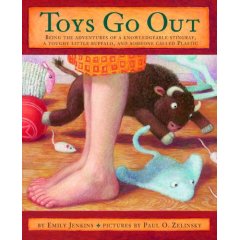
Toys Go Out, by Emily Jenkins and illustrated by Paul O. Zelinsky, is one of those increasingly rare books--Middle Grade fiction aimed at the younger reader. Perfect for the six-to ten-year-old audience (and even younger, if read aloud), Toys Go Out: Being the Adventures of a Knowledgeable Stingray, a Toughy Little Buffalo, and Someone Called Plastic tells what happens amongst the toys when no one is watching.
As the subtitle indicates, the movers and shakers in Little Girl's world are a stingray, a buffalo, and "someone called plastic." The first episode, "In the Backpack, Where it is Very Dark," finds the three friends (and rivals for Little Girl's affections) bouncing along in a backpack. They're afraid: Will they be thrown away? Are they going on a scary trip? Why does it smell so badly in the backpack? Fortunately they're the starring attraction at Show-and-Tell, their status as Little Girl's favorites confirmed.
Over the course of Toys Go Out, Stingray, Buffalo, and Plastic discover who they are and why each of them has a specific role in Little Girl's life. Stingray sleeps with Little Girl, Buffalo is a loved toy, and Plastic....Well, I'll let you discover who plastic is yourself.
Plastic, Buffalo, and Stingray are marvelous characters, but there's a fabulous supporting cast in Toys Go Out as well. Sheep is perhaps my favorite. When Buffalo hides because he's covered in peanut butter and does not want to go into the washing machine, he hides in a soccer shoe in the closet. Sheep wanders in and the following episode transpires:
"Sheep doesn't understand. She is distracted by the tasty-looking lace of the soccer shoe. It's not grass, and it's not clover, but it looks pretty chewable to the sheep.
She settles down next to the shoe and has herself a lovely munch, pulling the lace out bit by bit. She hears a Wurrffle Wummmpffle noise, and it's irritating, but she doesn't let it bother her. Pretty soon the sound quiets down to nothing.
When she is done chewing the lace, Sheep is mildly surprised to find herself in the closet. She burps and goes out to play pick-up sticks with the toy mice."
Buffalo is responsible for the Wurrffle Wummmpffle, being trapped in the shoe. Sheep, as you have read, had other concerns. The toys also interact with an urbane, intelligent, yellow towel named Tuk-Tuk and a grumpy, lonely washing machine.
Toys Go Out is highly recommended for children ages five to ten. It's funny, charming, and Zelinsky's drawings are a treat.
Toys Go Out has been nominated for The Cybils in the Middle Grade Fiction category.
As the subtitle indicates, the movers and shakers in Little Girl's world are a stingray, a buffalo, and "someone called plastic." The first episode, "In the Backpack, Where it is Very Dark," finds the three friends (and rivals for Little Girl's affections) bouncing along in a backpack. They're afraid: Will they be thrown away? Are they going on a scary trip? Why does it smell so badly in the backpack? Fortunately they're the starring attraction at Show-and-Tell, their status as Little Girl's favorites confirmed.
Over the course of Toys Go Out, Stingray, Buffalo, and Plastic discover who they are and why each of them has a specific role in Little Girl's life. Stingray sleeps with Little Girl, Buffalo is a loved toy, and Plastic....Well, I'll let you discover who plastic is yourself.
Plastic, Buffalo, and Stingray are marvelous characters, but there's a fabulous supporting cast in Toys Go Out as well. Sheep is perhaps my favorite. When Buffalo hides because he's covered in peanut butter and does not want to go into the washing machine, he hides in a soccer shoe in the closet. Sheep wanders in and the following episode transpires:
"Sheep doesn't understand. She is distracted by the tasty-looking lace of the soccer shoe. It's not grass, and it's not clover, but it looks pretty chewable to the sheep.
She settles down next to the shoe and has herself a lovely munch, pulling the lace out bit by bit. She hears a Wurrffle Wummmpffle noise, and it's irritating, but she doesn't let it bother her. Pretty soon the sound quiets down to nothing.
When she is done chewing the lace, Sheep is mildly surprised to find herself in the closet. She burps and goes out to play pick-up sticks with the toy mice."
Buffalo is responsible for the Wurrffle Wummmpffle, being trapped in the shoe. Sheep, as you have read, had other concerns. The toys also interact with an urbane, intelligent, yellow towel named Tuk-Tuk and a grumpy, lonely washing machine.
Toys Go Out is highly recommended for children ages five to ten. It's funny, charming, and Zelinsky's drawings are a treat.
Toys Go Out has been nominated for The Cybils in the Middle Grade Fiction category.






